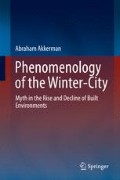Abstract
There is sufficient evidence to show that a mitigating factor against mood disorder during the late LIA, has been the city walk. Quite apart from its therapeutic effect, in the case of both René Descartes and Immanuel Kant, the walking experience through seventeenth and eighteenth centuries’ European streetscapes had thrust Descartes into his discovery of coordinate geometry, and Kant into his discernment of synthetic – a-priori concepts. In the nineteenth century the subjective experience of urban space has been also at the founding of European Existentialism. To Descartes orthogonally planned streets were the epitome of clear and distinct ideas as well as embryonic reference to axes x and y in a coordinate system. To Kant, according to some interpreters, direction in space was not absolute, but was the product of the body’s encounter with space, leading him – through walking – to consider geometry not as a mere neutral a-priori standard of spatiality, but one into which synthetic subjectivity is injected.
Access this chapter
Tax calculation will be finalised at checkout
Purchases are for personal use only
Bibliography
Akkerman, Abraham. 2001. Urban planning in the founding of Cartesian thought. Philosophy and Geography 4(2): 143–169.
Akkerman, Abraham. 2014. Winter-cities and mood disorder: Observations from the European city-form at the end of Little Ice Age. Trames Journal for the Humanities and Social Sciences 18(1): 19–37.
Bretall, Robert W. 1959. A Kierkegaard anthology. New York: Modern Library.
de Bievre, Elizabeth. 1995. The urban subconscious: The art of Delft and Leiden. Art History 18(2): 222–252.
de Quincey, Thomas. 1862. Last days of Immanuel Kant and other writings. Edinburgh: Adam and Charles Black.
Downtown Waterfront, Portland, OR, Aug 6, 2009 http://www.allacademic.com/meta/p377029_index.html
Elden, Stuart. 2009. Reassessing Kant’s geography. Journal of Historical Geography 35(1): 3–25.
Fellin, Renato, and Alessandro Blè. 1997. The disease of Immanuel Kant. The Lancet 9093(350): 1771–1773.
Gribkovskaia, Irina, Øyvind Halskau Sr., and Gilbert Laporte. 2007. The bridges of Königsberg: A historical perspective. Networks 49(3): 199–203.
Heine, George. 2009. Leonhard Euler’s contributions to mathematical cartography. Paper presented at the annual meeting of the Mathematical Association of America, Portland Marriott.
Hemelsoet, Dimitri, K. Hemelsoet, and D. Devreese. 2008. The neurological illness of Friedrich Nietzsche. Acta Neurologica Belgica 108(1): 9–16.
Kafka, Franz. 1912/1983. The sudden walk. In The penguin complete short stories of Franz Kafka, ed. Nahum Norbert Glatzer, 397. London: Allen Lane Publishers.
Kierkegaard, Søren. 1846/1974. Concluding unscientific postscript. English trans. by D.F. Swenson and W. Lowrie. Princeton: Princeton University Press.
Kierkegaard, Søren. 1847/1978. Kierkegaard’s writings, XXV: Letters and documents. Trans. and ed. H. Rosenmeier. Princeton: Princeton University Press.
Kierkegaard, Søren. 1848/1962. The crowd is untruth: On the dedication to “That Single Individual”. Trans. Bellinger, Charles. Fort Worth: TCU College.
Koolhaas, Rem. 1998. What ever happened to urbanism? In S, M, L, XL, ed. Rem Koolhaas. New York: The Monacelli Press.
Krell, David Farrell, and Donald L. Bates. 1997. The good European: Nietzsche’s work sites in word and image. Chicago: University of Chicago.
Lacour, Claudia Brodsky. 1996. Lines of thought: Discourse, architectonics, and the origin of modern philosophy. Durham: Duke University Press.
Lippitt, John. 2003. Routledge philosophy guidebook to Kierkegaard and fear and trembling. London: Routledge.
Merleau-Ponty, Maurice. 1961/2004. Eye and Mind. In Maurice Merleau-Ponty: Basic writings, ed. T. Baldwin, 295–324. London: Routledge.
Mokyr, Joel. 2007. The European enlightenment, the industrial revolution, and modern economic growth. In Max Weber lecture. Bellagio: European University Institute. 27 Mar 2007.
Nietzsche, Friedrich. 1882/1974. Gay science, with a prelude in rhymes and an appendix of songs. English trans. by Walter Kaufmann. New York: Vintage Books.
Nietzsche, Friedrich. 1885/1961. Thus Spoke Zarathustra. English trans. by R.J. Hollingdale. Baltimore: Penguin.
Sartre, Jean-Paul. 1964. Nausea. Trans from the French by Lloyd Alexander. New York: New Directions.
Serlio, Sebastiano. 1537/1982. The five books of architecture: An unabridged reprint of the english edition of 1611 (L’Architettura). New York: Dover Publications, and Don Mills, ON: General Publishing Company.
Soccio, Douglas J. 2007. Archetypes of wisdom: An introduction to philosophy. Belmont: Wadsworth.
Solomon, Robert C. 1972. From rationalism to existentialism: The existentialists and their nineteenth century backgrounds. Lanham: Rowman and Littlefield.
Ziolkowski, Eric. 2011. The Literary Kierkegaard. Evanston: Northwestern University Press.
Author information
Authors and Affiliations
Rights and permissions
Copyright information
© 2016 Springer International Publishing Switzerland
About this chapter
Cite this chapter
Akkerman, A. (2016). The Late LIA and Its Urban Sequel: Reason, Mental Illness and the Emergence of Crowd. In: Phenomenology of the Winter-City. Springer, Cham. https://doi.org/10.1007/978-3-319-26701-2_13
Download citation
DOI: https://doi.org/10.1007/978-3-319-26701-2_13
Published:
Publisher Name: Springer, Cham
Print ISBN: 978-3-319-26699-2
Online ISBN: 978-3-319-26701-2
eBook Packages: Religion and PhilosophyPhilosophy and Religion (R0)

